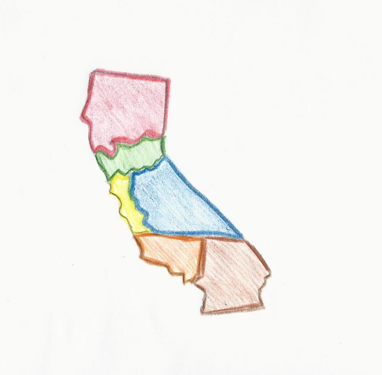As seen in the March 7 print edition
Max Stahl, comment editor
Tim Draper is little more than the latest one to the party. In December, the Silicon Valley millionaire proposed to divide California into six distinct states, the most recent of a long string of plans to partition America’s most populous and richest state. Obviously, all previous efforts have failed. And for good reason.
The partition of a state is not wholly unprecedented. In 1861 West Virginia seceded from Virginia in order to side with the Union in the Civil War. In 1820 Maine seceded from Massachusetts, from which it had been (and remains) geographically separated. But to divide California into six states is a different story. California is not – remarkably – polarized to Civil War proportions, nor is the state territorially discontiguous. It’s diverse, and it’s spacious, but that might actually work to its advantage.
California benefits from an incomparable variety of climates, populations, ideologies, economic activities, cultures, and so on. Draper seems to think that dividing the state would give individual groups or sectors greater representation in the state government, which in turn would be able to specialize its policy toward these more homogeneous interests. That may very well be the case, but such a system runs a crucial risk that California, as one state, has never had to deal with.
Assume that, for one reason or another, farmers in the Central Valley yield a particularly small crop one year. In our current state of California, this certainly would be a setback, but one from which the state could rebound. Worst case scenario: California loses some business and has to import more food from other states until crop yields return to normal levels.
In the proposed state of Central California, though, a poor harvest would be a disaster. The agricultural industry would dominate this hypothetical state, which encompasses the entire Central Valley. There wouldn’t be sufficient economic fallback, because Central California wouldn’t have enough industries in other sectors to compensate for the drop in business and food supply. The state would, in short, lack the means to effect its own recovery. One could imagine a similar scenario in the other states — a struggling movie business, say, or a decrease in tech revenue.
Perhaps worse, Draper’s plan could serve to make the rich richer and the poor poorer. It’s hard to deny that Silicon Valley would see some pretty noticeable benefits if it were its own state, and one might expect that West California, which would include Los Angeles and some surrounding cities, would experience similar economic growth. The same can hardly be said of the other four prospective states, which, as part of California, have benefitted from the ample tax revenue the state has collected from upper-income residents in and around Los Angeles and San Francisco. According to Time Magazine, Draper’s partition would create America’s wealthiest state, Silicon Valley, but it would also create one of America’s poorest: presumably Jefferson, the northernmost of the proposed states. Draper’s notion that, once separate, these states would be able to lift themselves up is ludicrous. California’s power to invest in infrastructure, business and education, and the facility with which California’s different regions can engage in commerce provides far greater opportunity for economic growth than the six-state plan.
Still further problems arise from California’s established programs and systems that run across the hypothetical state borders. The most relevant example to high-school students would have to be the state’s two public university systems, the UCs and CSUs. Reorganization of the state colleges would almost certainly be clumsy, confusing and costly, leaving few of the schools better off in the end. Similarly, California cities’ water rights would have to be reexamined and restructured. Draper has explained that his plan takes water rights into consideration, but, given the complexity of the current system (Los Angeles gets its water from Owens Valley, which would be in a different state if Draper’s proposal passed), his solution must be anything but perfect. Flaws such as these abound in the six-state plan.
Draper’s strongest argument points to the inefficiency of California’s government. And it’s true, this state does have serious problems, both institutional and political. However, a partition of California wouldn’t solve much in that respect. The state’s greatest failure is its ballot initiative system, which allows California voters to amend the state constitution with a simple majority vote. This system has produced harmful and often unworkable laws, and it’s the system through which Draper intends to pass his proposal.
Rather, Draper plans to create five new governorships, five new legislatures, five new bureaucracies. The Senate would have 10 more members. Each case would lead to greater inefficiency and greater polarization, with no guarantee that these governments would respond better to their citizens. As a single state, California has proven an exemplar of compromise and moderation. Its top-two primary system and anti-gerrymandering initiative have both served to keep California politics relatively close to the center of the political spectrum. If California were divided, two very liberal states — West California and Silicon Valley — would emerge, as would potentially three very conservative states — South California (which includes Orange County and San Diego, historically conservative areas), Central California and Jefferson. North California, which comprises Sacramento and surrounding cities, is a bit of a question mark, though it appears to lean to the left. With California as a single state, these regions check each other politically, and the result is usually a moderate, stable, if somewhat fraught political arena that leads the rest of the country by example. California enjoys prominent status in the US government because it is populous, wealthy and, most of all, a pioneer in compromise and moderation. Divide California into six states, and that power disappears.
Moving beyond politics and economics for a moment, let’s consider how dividing California might affect its population’s identity. Even though they may not be conscious of it, most Californians share a sense of pride and a perspective on life peculiar to this state. This is the state of the Bear Flag Revolt, of the Gold Rush, of John Steinbeck and John Fremont and John Muir (among other Johns), of natural wonders like Big Sur, Yosemite and Death Valley, of man-made wonders like the Golden Gate Bridge and Disneyland. Many of the state’s residents share that laid-back attitude exemplified by SNL’s “The Californians” sketch. To divide them into mostly arbitrarily defined and unimaginatively named (North California, South California, West California, Central California) states would be severing their identity. They’re not a people that needs to be divided, and they’re not a people that wants to be divided.
Californians should be open to discussion. They should be open to creative solutions to their state’s numerous and growing problems. They should be open to new ideas. But Draper’s isn’t a new idea. And it’s not a very good one either.





























